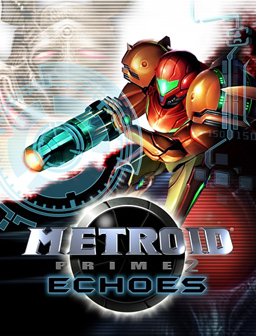
Metroid Prime 2: Echoes is an action-adventure game developed by Retro Studios and published by Nintendo for the GameCube. The sequel to Metroid Prime (2002) and the first Metroid game with a multiplayer feature, Echoes was released in North America, Europe and Australia in 2004 and in Japan under the name Metroid Prime 2: Dark Echoes in May 2005.

D2 is a survival horror video game developed by Warp for the Dreamcast. Directed and written by Kenji Eno, it was published by Warp in Japan in 1999 and by Sega in North America in 2000. D2 stars the "digital actress" Laura but has an independent story unrelated to the original D, and uses action-oriented gameplay in contrast to the puzzle-driven D.

Battlezone II: Combat Commander is a hybrid tank shooter, first-person shooter and real-time strategy video game, developed by Pandemic Studios, and published by Activision in 1999-2000. It is the sequel to the 1998 game Battlezone, in which players pilot various futuristic vehicles across different planets, along with building and managing additional units and structures. The game's story focuses on a conflict during an alternative 1990s period, in which humanity explores space for resources only to encounter an alien race in the process that they become locked in combat with. Although met with great enthusiasm, the game generated negative reviews due to bugs and other complaints by players, though retrospective reviews were more positive.

Kartia: The Word of Fate, known as Legend of Kartia in Europe and Rebus in Japan, is a tactical role-playing game developed and published by Atlus for Sony's PlayStation video game console in 1998. It is best known for the work of its art designer, Yoshitaka Amano, who had previously worked on the Final Fantasy series. Shigenori Soejima, another artist who would later be known for his work on the Persona series, also contributed to the game as an item graphics artist. The game was re-released on the Japanese PlayStation Network in 2011.

F355 Challenge is a racing simulation arcade video game based on the race car and Ferrari event. It was developed by the AM2 division of Sega for the Sega Naomi Multiboard arcade system board under the direction of Yu Suzuki, and was later ported to the Dreamcast and PlayStation 2 home video game consoles under the names F355 Challenge: Passione Rossa and Ferrari F355 Challenge respectively for both American and European releases. The only model of car featured in the game is the Ferrari F355 Challenge model. The game was considered the most accurate simulation of the F355 possible up until that time.

Julie Ann Strain was an American actress and model. She was chosen by Penthouse as Pet of the Month in June 1991 and Pet of the Year in 1993. Her biggest mainstream acting role was Julie, the protagonist in Heavy Metal 2000.

Madden NFL 2001 is an American football video game. It is the third in the Madden NFL series to include an NFL player, Tennessee Titans running back Eddie George, on its cover. In addition, it is the first game in the series to have a player, instead of John Madden featured prominently on the box art. Madden's picture is shown on a small logo, which would reappear for every following game until Madden NFL 06. It is also the first game in the Madden NFL series to appear on the PlayStation 2 game console. This is the first Madden game to feature NFL Europe teams.

V-Rally 2 is a racing video game developed by Eden Studios and published by Infogrames for PlayStation, Dreamcast and Microsoft Windows. It was originally planned for release as a Nintendo 64 title, but was cancelled during the early development phases of the game and was never officially announced.

Tomb Raider: The Last Revelation is an action-adventure video game developed by Core Design and published by Eidos Interactive. It was first released for PlayStation and Microsoft Windows in 1999, then on Dreamcast and Mac OS the following year. It is the fourth instalment in the Tomb Raider series. The narrative follows archaeologist-adventurer Lara Croft as she races to imprison the Egyptian god Set after accidentally setting him free. Gameplay features Lara navigating levels split into multiple areas and room complexes, fighting enemies and solving puzzles to progress.

WWF SmackDown! Just Bring It, known in Japan as Exciting Pro Wrestle 3, is a professional wrestling video game developed by Yuke's, and published by THQ for PlayStation 2, and was released in November 2001. It is the third game in the WWF SmackDown! series, based on the World Wrestling Federation (WWF) professional wrestling promotion, the sequel to WWF SmackDown! 2: Know Your Role, the first game in the series to be released on the PlayStation 2 console, and the last game in the series to be released under the "WWF" name.
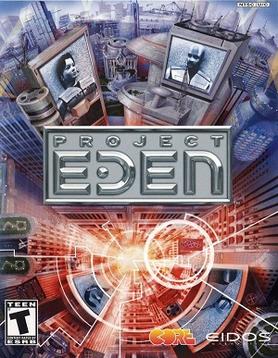
Project Eden is a 2001 action-adventure video game developed by Core Design and published by Eidos Interactive. It was released for Microsoft Windows and PlayStation 2. The planned Dreamcast version was cancelled. The plot involves a squad of four law enforcement agents investigating the disappearances of people by working their way downwards through layers of a towering mega-city. Project Eden's gameplay emphasises puzzle-solving, requiring the player or players to control each of the four characters and use their individual abilities to make progress. A single player can control any one of the characters, and jump between them at will or up to four players can play simultaneously as different members of the team.

Sacrifice is a real-time strategy video game published by Interplay Entertainment in 2000 for Microsoft Windows platform. Developed by Shiny Entertainment, the game features elements of action and other genres. Players control wizards who fight each other with spells and summoned creatures. The game was ported to Mac OS 9.2 in 2001.
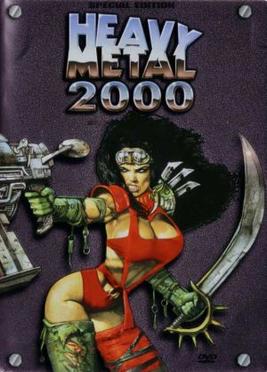
Heavy Metal 2000 is a 2000 Canadian adult animated science fiction film produced by Jacques Pettigrew and Michel Lemire, and directed by Michael Coldewey and Lemire. Starring the voices of Michael Ironside, Julie Strain, and Billy Idol, the film is the follow-up to the 1981 animated cult film Heavy Metal, which is based on the fantasy magazine of the same name. The story is based on the graphic novel, The Melting Pot, written by Kevin Eastman, Simon Bisley and Eric Talbot. The film was made by CinéGroupe, a studio based in Montreal, Quebec. It received negative reviews on Rotten Tomatoes.
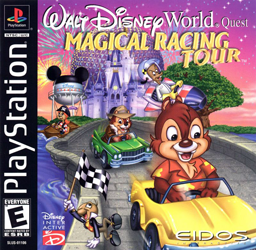
Walt Disney World Quest: Magical Racing Tour, sometimes mislabeled as Disney MT Racing or Walt Disney World: Magical Racing Quest, is a 2000 go-kart racing video game based on attractions at the Walt Disney World Resort. Players compete in races on tracks inspired by attractions such as the Haunted Mansion, Pirates of the Caribbean, Space Mountain and Big Thunder Mountain Railroad to acquire missing parts for the park's fireworks machine, which was accidentally destroyed by Chip 'n' Dale while they were gathering acorns. The game was developed by Crystal Dynamics and published by Eidos Interactive. The Game Boy Color version was developed by Silent Software.

POD 2: Multiplayer Online is the sequel to the 1997 racing game POD, made by Ubisoft and available for Dreamcast in 2000.

AeroWings 2: Airstrike, known in Japan as Aero Dancing F, is a combat flight simulator developed and published by CRI, and Crave Entertainment for the Dreamcast console. It is the sequel to AeroWings. An updated version of the game, called Aero Dancing F: Todoroki Tsubasa no Hatsu Hikō, was released for Dreamcast and Microsoft Windows only in Japan on November 16, 2000.

X-Squad, known in Japan as X-Fire/Crossfire, is a PlayStation 2 launch title developed by Electronic Arts Square and published by EA Games. It was released on August 3, 2000 in Japan, October 26 in the U.S. and on December 8 in Europe.
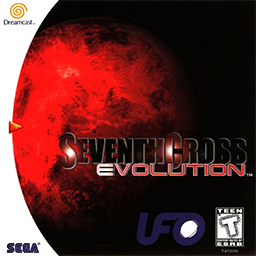
Seventh Cross: Evolution, known in Japan as simply Seventh Cross, is a video game for the Sega Dreamcast video game console. It was released in Japan on December 23, 1998. A sequel titled Ninth Will was announced shortly after the game's North American release, but it was apparently cancelled.
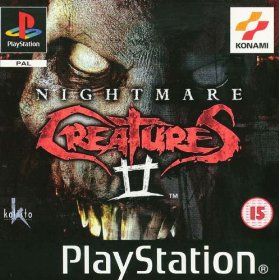
Nightmare Creatures II is a survival horror video game developed by Kalisto Entertainment and published by Konami for the PlayStation and Dreamcast. It is the sequel to Nightmare Creatures.

Might & Magic Heroes VI is a turn-based strategy video game for Microsoft Windows developed by Black Hole Entertainment and published by Ubisoft. Some patches and downloadable content were developed by Limbic Entertainment, while the standalone expansion Shades of Darkness was developed by Virtuos. It is the sixth installment in the Heroes of Might and Magic series, and was released on October 13, 2011, coinciding with the 25th anniversary of the Might and Magic franchise. Heroes VI acts as a prequel to Heroes of Might and Magic V, occurring almost five centuries earlier, and is set in the fictional world of Ashan. The story follows the five heirs to the Griffin dynasty in their quests to repel a demon invasion and assist or impede Michael, a legendary Archangel general plotting to revive an ancient war.




















